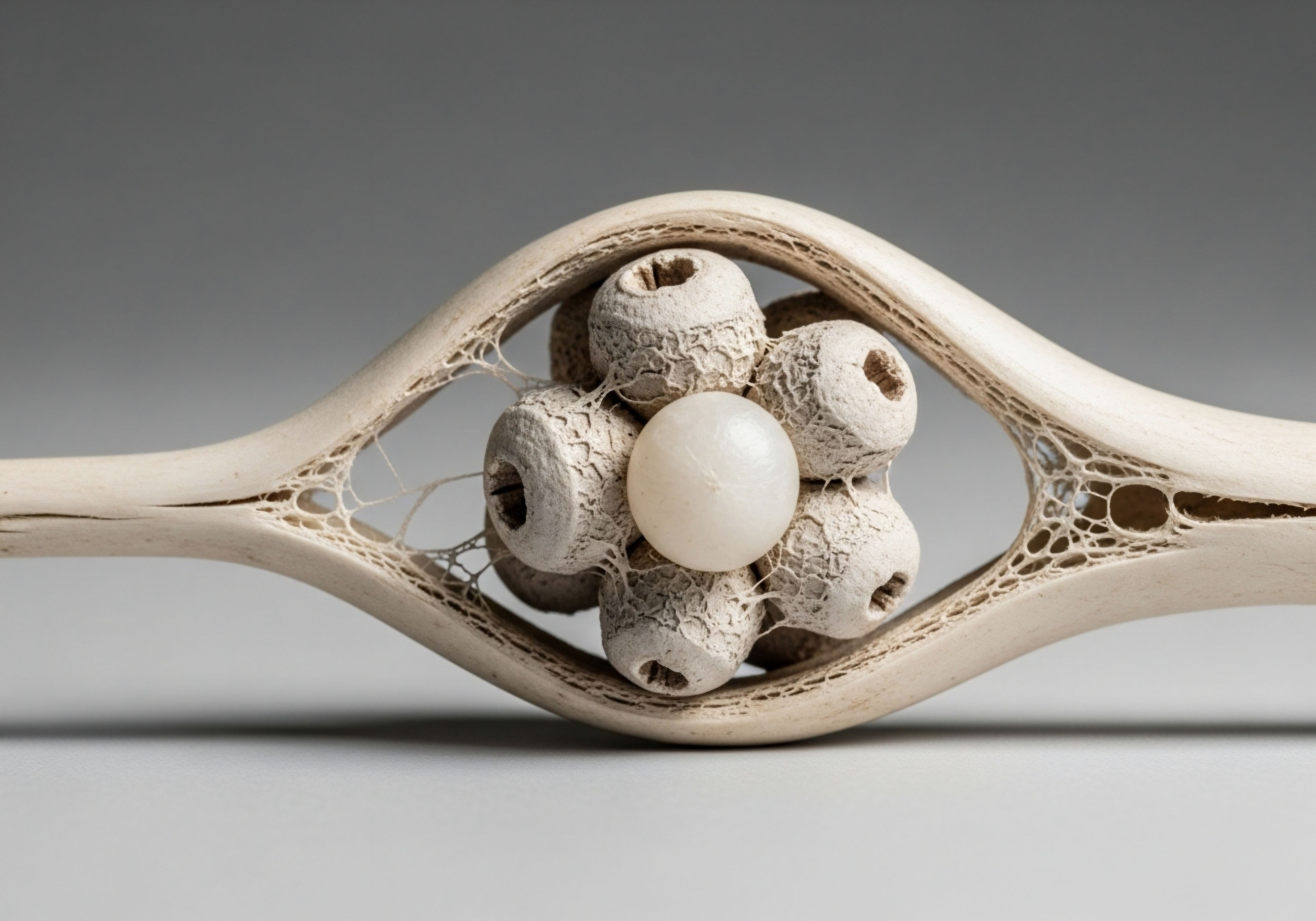

Fundamentals
Embarking on a path involving anabolic agents often begins with a clear objective ∞ to enhance physical capacity, build muscle, and redefine one’s physical presence. This pursuit is deeply personal, rooted in a desire for self-improvement and control over one’s body. The immediate, visible results can be validating, reinforcing the choice to use these powerful compounds.
Yet, beneath the surface of these physical changes, a complex biological narrative unfolds, one that has profound and lasting implications for reproductive health. Understanding this narrative is essential for anyone considering or currently using these substances without clinical oversight.
The human endocrine system is a finely tuned network of communication. Hormones act as chemical messengers, traveling through the bloodstream to regulate countless bodily functions, from metabolism and mood to sleep and sexual function. At the heart of male reproductive health is the Hypothalamic-Pituitary-Gonadal (HPG) axis.
This intricate system functions like a sophisticated thermostat, constantly monitoring and adjusting the production of key hormones to maintain balance. The hypothalamus, a small region in the brain, releases Gonadotropin-Releasing Hormone (GnRH). This signals the pituitary gland, another crucial brain structure, to produce Luteinizing Hormone (LH) and Follicle-Stimulating Hormone (FSH).
In men, LH stimulates the Leydig cells in the testes to produce testosterone, while FSH is vital for spermatogenesis, the process of sperm production. This entire system operates on a negative feedback loop; when testosterone levels are sufficient, the hypothalamus and pituitary gland reduce their signaling to prevent overproduction.
Unsupervised anabolic steroid use disrupts the body’s natural hormonal symphony, leading to significant and often prolonged reproductive consequences.
When external anabolic-androgenic steroids (AAS) are introduced into the body, especially at the supraphysiological doses common in unsupervised settings, this delicate feedback loop is profoundly disrupted. The body detects an abundance of androgens and interprets it as a signal to shut down its own production.
The hypothalamus reduces or stops releasing GnRH, which in turn halts the pituitary’s output of LH and FSH. This shutdown of the HPG axis leads to a state known as exogenous hypogonadotropic hypogonadism. The testes, deprived of the signals from the pituitary, shrink and cease their two primary functions ∞ producing testosterone and creating sperm. This biological response is the root cause of the reproductive consequences seen with unsupervised AAS use.
The immediate effects on fertility can be stark. Many men experience a dramatic reduction in sperm count (oligospermia) or a complete absence of sperm in the ejaculate (azoospermia). While these effects are often reversible after discontinuing AAS, the timeline for recovery is highly variable and not guaranteed.
The process of restarting the H1PG axis can be slow and arduous, with some individuals experiencing prolonged periods of low testosterone and impaired fertility for months or even years after their last dose. This period of post-AAS hypogonadism can be physically and emotionally challenging, marked by symptoms such as low libido, erectile dysfunction, fatigue, and depression. It is a stark contrast to the feelings of vitality often experienced while using AAS, making the recovery process even more difficult.
For women who use anabolic steroids, the consequences are equally severe and can be irreversible. The introduction of high levels of androgens disrupts the menstrual cycle, leading to irregularities, anovulation (the absence of ovulation), and in some cases, a complete cessation of periods. The physical changes can also be profound, including clitoral hypertrophy and uterine atrophy.
These alterations to the reproductive organs can have a lasting impact on fertility, making it difficult to conceive even long after discontinuing the substances. The journey back to hormonal balance can be a long one, requiring patience, medical guidance, and a deep understanding of the body’s intricate hormonal architecture.


Intermediate
For individuals who have a foundational understanding of the hormonal shutdown caused by anabolic steroid use, the next logical step is to examine the clinical mechanics of this process and the strategies employed to mitigate the damage.
The conversation shifts from the “what” to the “how” ∞ how exactly does the body’s reproductive signaling collapse, and what clinical interventions are available to encourage its restoration? This requires a more detailed look at the specific hormones involved and the pharmacodynamics of both anabolic agents and recovery protocols.
The suppression of the HPG axis by exogenous androgens is a dose-and-duration-dependent phenomenon. The higher the dose and the longer the duration of use, the more profound and prolonged the subsequent shutdown will be. This suppression is not a simple on/off switch but a progressive silencing of a complex biological conversation.
The constant presence of synthetic androgens effectively convinces the hypothalamus that no more testosterone is needed, leading to a cessation of GnRH pulses. Without these pulses, the pituitary gland’s gonadotroph cells, which produce LH and FSH, become dormant. This leads to testicular atrophy, as the Leydig and Sertoli cells within the testes are deprived of their primary stimulating signals.
The recovery from anabolic steroid-induced hypogonadism is a complex process that often requires a multi-faceted clinical approach to reawaken the dormant HPG axis.
When an individual ceases unsupervised AAS use, they enter a challenging transitional phase. The suppressive effects of the exogenous hormones can linger, while the body’s natural production remains offline. This results in a period of profound hypogonadism, with low levels of both LH, FSH, and testosterone.
Symptoms can be severe, including a complete loss of libido, erectile dysfunction, lethargy, and mood disturbances. The duration of this state can vary from weeks to months, and in some cases, a full recovery of the HPG axis may not occur without intervention.

Protocols for Restoring HPG Axis Function
Clinicians have developed several protocols to address anabolic steroid-induced hypogonadism (ASIH) and to stimulate the recovery of the HPG axis. These protocols are designed to restart the body’s natural testosterone production and restore fertility. It is important to note that these are medical interventions that require the guidance of a qualified physician. Self-administering these protocols can be dangerous and may worsen the situation.

Post-Cycle Therapy (PCT) a Clinical Perspective
In a clinical setting, a post-TRT or fertility-stimulating protocol is sometimes used for men who have discontinued TRT or are recovering from unsupervised AAS use. The goal is to stimulate the HPG axis at multiple points to encourage a return to normal function. These protocols often involve a combination of medications:
- Clomiphene Citrate (Clomid) This is a selective estrogen receptor modulator (SERM) that works by blocking estrogen receptors in the hypothalamus. This action tricks the brain into thinking that estrogen levels are low, which in turn stimulates the release of GnRH, leading to increased production of LH and FSH.
- Tamoxifen Citrate (Nolvadex) Another SERM that functions similarly to clomiphene, blocking estrogen receptors in the pituitary gland. This also helps to stimulate the release of LH and FSH.
- Human Chorionic Gonadotropin (hCG) This is a hormone that mimics the action of LH. It directly stimulates the Leydig cells in the testes to produce testosterone. hCG is often used to maintain testicular size and function during a suppressive cycle or to “jump-start” the testes during recovery. However, its use must be carefully managed, as it can also be suppressive to the HPG axis over time.
- Anastrozole An aromatase inhibitor that blocks the conversion of testosterone to estrogen. It can be used to manage estrogen levels during recovery, particularly when using hCG, which can lead to elevated estrogen.
The specific combination and dosage of these medications will vary depending on the individual’s history of AAS use, their current hormone levels, and their specific goals (e.g. restoring fertility vs. simply normalizing testosterone levels). A typical protocol might involve a course of hCG followed by a period of treatment with a SERM like clomiphene or tamoxifen.

What Are the Long Term Effects on Sperm Quality?
While the focus is often on restoring hormone levels, the impact on spermatogenesis can be equally significant. The recovery of sperm production often lags behind the normalization of hormone levels. Even after testosterone levels have returned to the normal range, it can take several months for sperm count, motility, and morphology to recover. In some cases, particularly after prolonged use of high doses of AAS, the damage to the Sertoli cells can be long-lasting, resulting in persistent infertility.
The table below outlines the typical timeline for the recovery of reproductive function after discontinuing unsupervised AAS use. It is important to remember that this is a general guideline, and individual experiences can vary significantly.
| Parameter | Time to Recovery | Notes |
|---|---|---|
| LH and FSH | 13-24 weeks | Gonadotropin levels are typically the first to recover as the HPG axis begins to function again. |
| Serum Testosterone | 4-12 months | Testosterone levels often take longer to normalize and may remain low for a significant period after discontinuing AAS. |
| Sperm Parameters | 4-12+ months | The recovery of sperm count, motility, and morphology is often the slowest aspect of reproductive recovery. |
The journey back from unsupervised anabolic use is a complex one, requiring a deep understanding of the endocrine system and a patient, methodical approach to recovery. It is a process of re-establishing a delicate biological conversation that was silenced by the introduction of powerful external signals. While the body has a remarkable capacity for healing, the long-term reproductive outcomes are never certain, highlighting the profound risks associated with using these substances outside of a clinical setting.


Academic
A comprehensive academic exploration of the long-term reproductive sequelae of unsupervised anabolic-androgenic steroid (AAS) use necessitates a move beyond the description of HPG axis suppression into a detailed analysis of the cellular and molecular mechanisms at play.
This requires an examination of the direct gonadotoxic effects of these compounds, the potential for permanent alterations in endocrine signaling pathways, and the genetic and epigenetic changes that may underlie persistent subfertility. From a clinical and research perspective, the central question is not just whether the HPG axis recovers, but to what extent the gonadal tissue itself retains its full functional capacity after prolonged exposure to supraphysiological androgen levels.
The state of anabolic steroid-induced hypogonadism (ASIH) is the primary clinical presentation, characterized by the suppression of endogenous gonadotropin and testosterone production. However, the long-term reproductive prognosis is dictated by the resilience of the testicular microenvironment, specifically the Leydig and Sertoli cells.
Research indicates that while HPG axis function may eventually resume in many individuals, a significant subset experiences persistent primary hypogonadism, suggesting a degree of irreversible testicular damage. This points to a direct cellular toxicity of AAS, independent of their suppressive effects on the HPG axis.

Cellular Mechanisms of Gonadal Toxicity
The testicular damage observed in AAS users can be attributed to several interconnected cellular processes. One of the primary mechanisms is the induction of oxidative stress. Supraphysiological doses of androgens have been shown to increase the production of reactive oxygen species (ROS) within the testes.
This excess ROS can overwhelm the local antioxidant defense mechanisms, leading to lipid peroxidation, protein damage, and DNA fragmentation in both Leydig and Sertoli cells, as well as in developing spermatids. This oxidative damage can impair steroidogenesis in Leydig cells and disrupt the supportive function of Sertoli cells, which is essential for spermatogenesis.
Another key mechanism is the induction of apoptosis, or programmed cell death. High concentrations of androgens can trigger apoptotic pathways in testicular germ cells, leading to a depletion of the spermatogonial stem cell pool. This can result in a long-lasting or even permanent reduction in sperm production.
The pro-apoptotic effects of AAS are mediated through complex signaling cascades involving the Bcl-2 family of proteins and the activation of caspases. This process effectively culls the cells responsible for creating new sperm, leading to the observed outcomes of oligospermia and azoospermia.

The Role of Aromatization and Estrogen
Many anabolic steroids are aromatizable, meaning they can be converted into estrogens by the enzyme aromatase. In the context of supraphysiological AAS use, this can lead to extremely high levels of estrogen in men. While estrogen plays a crucial role in male reproductive physiology, excessive levels can be detrimental.
High estrogen can directly suppress spermatogenesis and has been linked to Leydig cell dysfunction. Furthermore, the elevated estrogen-to-androgen ratio is the primary driver of gynecomastia, a common side effect of AAS use. The use of aromatase inhibitors like anastrozole is a common practice among AAS users to mitigate this effect, but this adds another layer of pharmacological intervention with its own set of potential long-term consequences.

Genetic and Epigenetic Alterations
Emerging research suggests that the reproductive consequences of AAS use may extend to the genetic and epigenetic level. The DNA damage caused by oxidative stress can lead to mutations in sperm DNA, which could have implications for the health of offspring if conception is achieved.
Furthermore, AAS use may induce epigenetic changes, such as alterations in DNA methylation patterns and histone modifications. These epigenetic marks can influence gene expression in sperm and may be heritable. While this field of research is still in its infancy, it raises serious questions about the transgenerational effects of unsupervised AAS use.
The table below summarizes the key cellular and molecular mechanisms underlying the long-term reproductive effects of unsupervised AAS use.
| Mechanism | Affected Cells | Consequence |
|---|---|---|
| HPG Axis Suppression | Hypothalamus, Pituitary | Decreased LH and FSH production, leading to secondary hypogonadism. |
| Oxidative Stress | Leydig cells, Sertoli cells, Spermatids | Cellular damage, impaired steroidogenesis, and reduced sperm quality. |
| Apoptosis | Germ cells | Depletion of spermatogonial stem cells, leading to long-term oligospermia or azoospermia. |
| Aromatization | Multiple tissues | Elevated estrogen levels, which can suppress spermatogenesis and cause gynecomastia. |
| Genetic/Epigenetic Changes | Sperm | Potential for DNA mutations and heritable epigenetic alterations. |
The long-term reproductive outcomes of unsupervised anabolic steroid use are a complex interplay of endocrine disruption, direct cellular toxicity, and potential genetic and epigenetic modifications. While many individuals may experience a return of HPG axis function and fertility, a significant number are at risk for persistent primary hypogonadism and subfertility. The decision to use these powerful compounds carries with it a substantial and often unpredictable risk to one of the most fundamental aspects of human biology.

References
- Christou, M. A. et al. “Effects of Anabolic Androgenic Steroids on the Reproductive System of Athletes and Recreational Users ∞ A Systematic Review and Meta-Analysis.” Sports Medicine, vol. 47, no. 9, 2017, pp. 1869-1883.
- Nieschlag, E. & Behre, H. M. (Eds.). (2012). Testosterone ∞ Action, Deficiency, Substitution. Cambridge University Press.
- De Souza, G. L. & Hallak, J. (2011). Anabolic steroids and male infertility ∞ a comprehensive review. BJU international, 108(11), 1860-1865.
- Rahnema, C. D. Lipshultz, L. I. & Crosnoe, L. E. (2014). Anabolic steroid-induced hypogonadism ∞ diagnosis and treatment. Fertility and sterility, 101(5), 1271-1279.
- Coward, R. M. Rajanahally, S. & Kovac, J. R. (2013). Anabolic-androgenic steroid-induced hypogonadism in the male. Current opinion in endocrinology, diabetes, and obesity, 20(3), 225.
- Griffin, J. E. & Wilson, J. D. (2008). Disorders of the testes and male reproductive tract. In Williams Textbook of Endocrinology (11th ed. pp. 681-748). Saunders Elsevier.
- Thompson, P. D. et al. (2004). Left ventricular function is not impaired in weight-lifters who use anabolic steroids. Journal of the American College of Cardiology, 44(1), 178-180.
- Pope, H. G. Wood, R. I. & Rogol, A. (2014). The adverse health consequences of performance-enhancing drugs ∞ an Endocrine Society scientific statement. Endocrine reviews, 35(3), 341-375.
- Kanayama, G. Hudson, J. I. & Pope, H. G. Jr. (2010). Illicit anabolic ∞ androgenic steroid use. Hormones and behavior, 58(1), 111-121.
- Hartgens, F. & Kuipers, H. (2004). Effects of androgenic-anabolic steroids in athletes. Sports medicine, 34(8), 513-554.

Reflection
The information presented here offers a clinical map of the territory, detailing the biological roads and potential dead ends associated with unsupervised anabolic use. This knowledge is a tool, a lens through which to view your own body and the choices you make for it.
The path forward is a personal one, shaped by your unique physiology, history, and goals. The data and mechanisms described are the beginning of a conversation, not the final word. True understanding comes from integrating this clinical knowledge with your own lived experience, recognizing that your body’s responses are the most important data points of all. This journey of self-discovery is the first and most critical step toward reclaiming and optimizing your biological potential.



